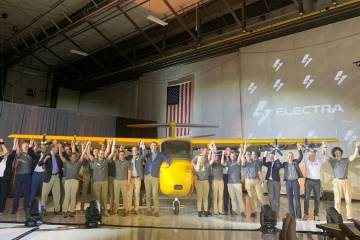Electra Aero has built a technology demonstrator vehicle that it will use to complete the development of its hybrid-electric short takeoff and landing (eSTOL) aircraft. During an event on Monday attended by some 200 guests at its headquarters in Manassas, Virginia, the company revealed the two-seat model, which it says is the world’s first blown-lift aircraft powered by distributed electric propulsion.
Flight testing is expected to start in the third quarter to track performance that will help Electra’s engineers complete the design of the nine-passenger production aircraft that could also be used to carry 2,500 pounds of freight. The company is aiming to produce an aircraft with exceptional short takeoff and landing performance that will be able to operate from landing surfaces of little more than 300 feet and fly routes of around 400 nm at a cruise speed of 175 knots. If operated from longer runways up to 1,000 feet, payload and range could be increased.
The eSTOL aircraft’s propulsion system consists of eight electric motors and a turbogenerator that can recharge batteries in flight and run on sustainable aviation fuel. Electra said this capability has the added benefit of avoiding the need for ground recharging infrastructure, giving far greater scope for the eSTOL aircraft to operate from multiple locations, including city-center landing sites and more than 5,000 underutilized public airports in the U.S.
[inline-image=”221822”]
Electra is now selecting a supplier for the turbogenerator and another to provide fly-by-wire controls. It plans to be ready to fly a full-scale prototype in 2025 as it advances toward FAA Part 23 type certification in 2028.
The technology demonstrator, which the company has named the Gold Finch, is about the size of a Cessna 172 light aircraft and around 80 percent of the scale of the prototype. The prototype will be the same size as the production aircraft, albeit not fully conforming.
Truck-based Ground Testing Now Complete
Electra has already conducted extensive ground tests with the propulsion system and has also mounted the demonstrator on a truck to drive it down Manassas’s Virginia Municipal Airport runway at speeds between 30 and 60 knots. Marc Ausman, the company’s chief product officer, told FutureFlight that engineers have been able to change the aircraft’s angle of attack and flap settings during ground runs that have generated data to be compared with its computer models. He said that this progressive approach, which began with flying a much smaller subscale model, has reduced the program’s technology risk.
“In the three years since we founded Electra, we’ve designed our eSTOL aircraft, validated our blown-lift technology with a subscale demonstrator, and run a fully integrated test of our 150-kilowatt hybrid-electric generator at full-scale,” said Electra’s founder and CEO, John Langford. “Now we’re ready to test the entire system with this technology demonstrator aircraft. We can’t wait to fly this plane and show the world what our eSTOL aircraft can do.”
According to Electra, it holds letters of intent for over 1,200 aircraft, which could lead to firm orders worth more than $4 billion—implying a unit price of around $3.3 million. The company recently raised $85 million in new funding, which includes a $30 million award from the U.S. Air Force to develop potential military applications for eSTOL aircraft.
According to Ausman, most of the 32 prospective customers are Part 135 operators operating fleets of aircraft, with some Part 91 private operators in the mix as well. Almost three-quarters of the anticipated clients are already flying commercial operations, mainly with aircraft such as Textron’s King Air, Caravans, and Skycourier, as well as Pilatus PC-12s.
Blown-wing technology (sometimes referred to as blown lift) involves an aerodynamic effect in which by increasing the flow of air over the wing, the lift is generated at a much slower airspeed than with conventional aircraft. This is a key factor in the anticipated eSTOL performance of Electra’s design and also is expected to improve energy efficiency.


